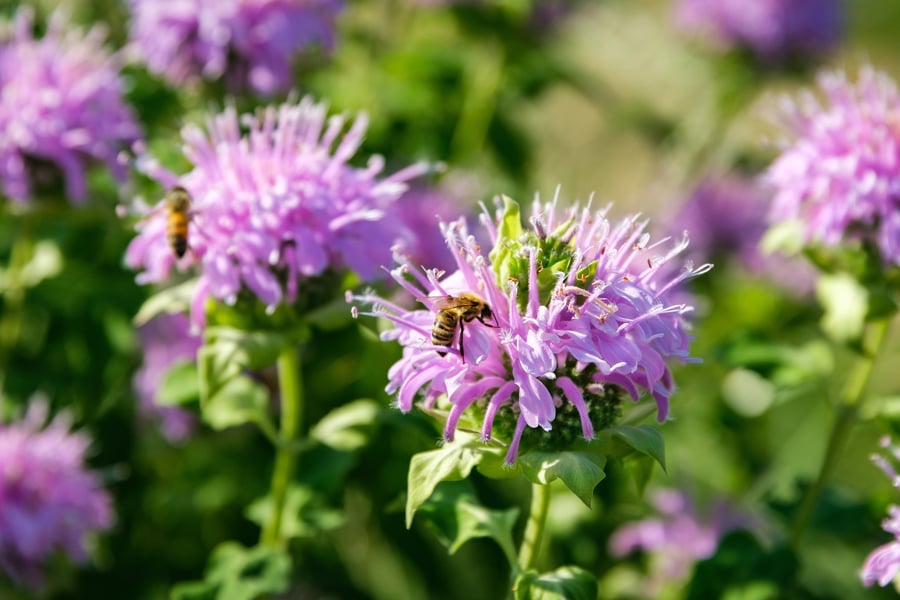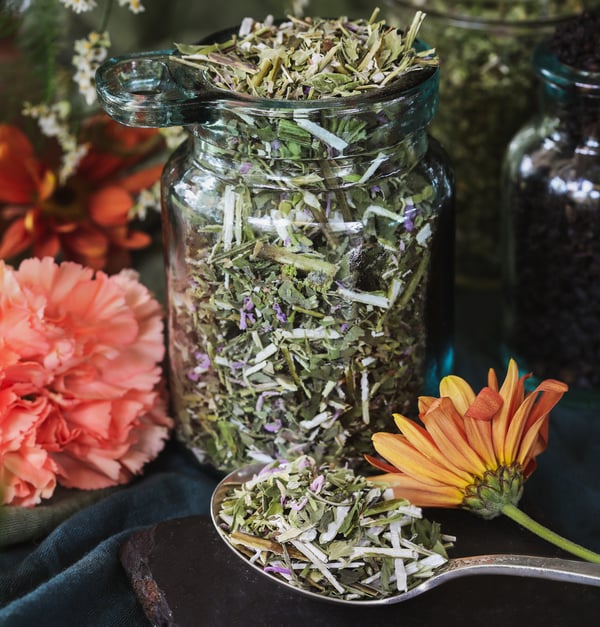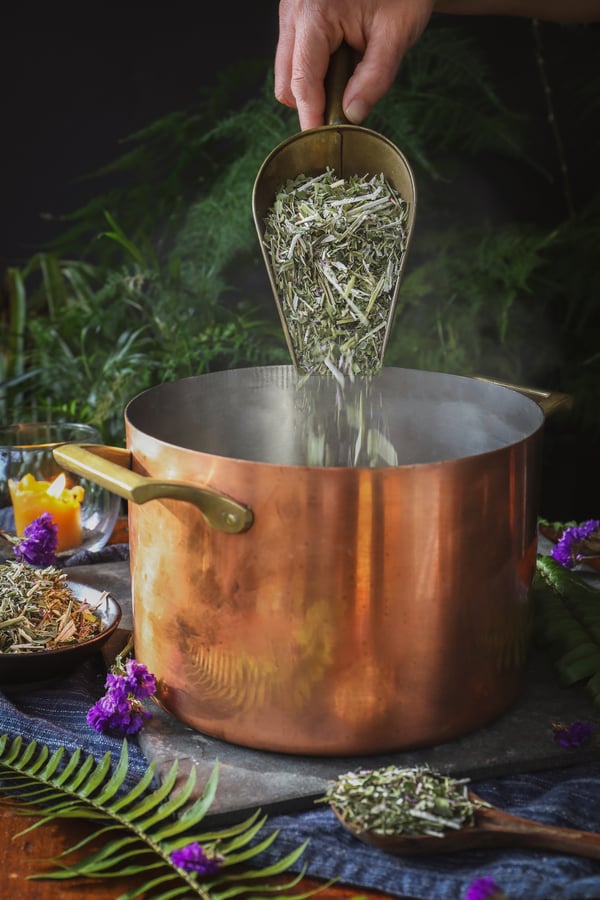There is always happy anticipation around Mountain Rose Herbs when we get the opportunity to bring in a new herbal ally. And when that botanical is grown by one of our passionate, conscientious farm partners right here in Oregon, our excitement is tinged with some home-state pride. So, we are pleased to announce that we are now carrying organic bee balm (Monarda fistulosa) grown at Oregon’s own Oshala Farm!
Flower and pollinator enthusiasts will recognize bee balm as a beautifully brilliant flower that spreads rapidly in a flower bed via rhizomes and is much loved by pollinators. Monarda is the genus of these flowering plants: members of the large Lamiaceae (mint) family and native to North America. There are over 20 species in the Monarda genus. Named after the 16th-century Spanish botanist, Nicolás Monardes, who studied medicinal plants of the Americas, Monarda includes several species that have been specifically bred for the quality of their blooms in flower gardens. These hybrids generally come from Monarda didyma (also known as scarlet bee balm) and Monarda fistulosa (sometimes called wild bergamot) and range in color from brilliant reds and purples to creamy white. Bee balms flower in mid-summer and may continue to bloom into early fall.
As well as the common names of “bee balm” and “wild bergamot,” you may hear the various species of Monarda referred to as oswego tea, horsemint, or sweet leaf (the crushed leaves of all Monarda species, and particularly Monarda didyma, exude a spicy, fragrant essential oil). Note that the common name “wild bergamot” should not be confused with the similarly-scented bergamot that is associated with essential oil and Earl Grey tea—that bergamot is a different plant: Citrus bergamia.
In the wild, bee balm can be found throughout North America, up to elevations as high as 5,000 feet. It loves moist meadows, hillsides, and forest clearings. It is also quite happy to grow in good home garden soil, where it serves triple duty as a beautiful and long-lasting bedding plant, an excellent food source for pollinators and hummingbirds, and an easy-to-use herbal ally.
Bee balm's leaves and flower buds are edible and taste a bit like spearmint or peppermint with a strong oregano component. Their high thymol content can also make them taste somewhat bitter, although some species are stronger tasting than others. Culinary accounts from the early Americas tell us that many Indigenous communities used bee balm as a common seasoning for wild game. Today, people use it in dishes that call for Mediterranean herbs like oregano and thyme. If eating fresh, the individual flowers are perfect when they’re at their peak; the central flower heads are very fibrous, however, so you’ll enjoy the flowers better if you pull them from the flower head.
Why We Purchase Our Organic Bee Balm at Oshala Farm
Oshala Farm is the wonderful result of a passion for herbalism combined with a passion for farming. Our friends Elise (the herbalist of the duo) and Jeff (organic farmer extraordinaire) work with their son, Will, and an amazing, dedicated crew to produce some of the finest certified organic herbs. Founded in 2013, this family-run farm is 113 acres, tucked into the lush Applegate Valley of Southwestern Oregon. The team exclusively uses regenerative, sustainable cultivation practices, working in harmony with the land to grow over 80 varieties of medicinal and culinary herbs.
As well as growing and processing fresh and dried herbs, Oshala Farm hosts educational events on the farm, seasonal farm tours, and an annual Herb Camp. They are devoted advocates for small family farms, seed integrity, and seed saving, and have worked through Our Family Farms Coalition to support a Jackson County ban on genetically engineered crops. It is our honor and responsibility to promote and support farmers with this level of commitment to the wellbeing of the land and the community it feeds.
Monarda in Herbalism
Two species of Monarda—Monarda fistulosa and Monarda didyma—have a long history of use as medicinal and culinary plants by First Nations peoples. The Blackfoot, Winnebago, Ojibwa, and others used the aerial parts of the plant in poultices for stings (hence the name bee balm) and minor skin issues; as a gargle for problems with the mouth, gums, and throat; as a carminative herb to address gut discomfort and gas; and as an herbal steam to help comfort the sinuses and ease congestion in the respiratory system.*
In Western Herbalism, herbalists often make infused honey or an oxymel (herb-infused vinegar) to extract the constituents in bee balm. However, the constituents in Monarda may also be extracted and utilized via water (tea), tincture, infused oil, poultices and compresses, herbal butter, pesto, salad dressing, etc. And, just as First Nations peoples used this herb, a bee balm herbal steam can be wonderfully helpful when our sinuses are feeling full of muck.*
Cautions: Bee balm is considered generally safe but is a traditional menstrual stimulant, so is not recommended if you are pregnant or trying to get pregnant. Also, because it is a spicy herb, it can exacerbate heartburn.
How to Make a Bee Balm Steam Inhalation for Respiratory Support
Makes enough for 1 steam.
Ingredients
- About 4-6 cups boiling water
- 2 - 2 1/2 cups dried organic bee balm leaves and flowers
Directions
- Have a large bath towel and a wide bowl ready: wide enough so you can get your whole face over the bowl.
- Add bee balm to boiling water, cover, and allow to simmer briefly. Pour water and herb(s) into the wide bowl.
- Put your head over the bowl and tent the towel over your head, shoulders, and bowl to capture the herbal steam as you inhale.
- Inhale deeply and continue to breathe slowly and deeply as long as the fragrant steam lasts or you can’t stand it any longer.
- Alternatively, fill a cotton/muslin bag with dried herb(s) and drop it into a warm bath. Soak as long as it feels good. This is a good option for children or simply for a relaxing, rejuvenating soak.
Pro Tip: You can replace half the bee balm with dried organic eucalyptus leaves for an extra powerful steam. Alternatively, add 2-3 drops of eucalyptus, rosemary, or peppermint essential oil to the water after removing from the heat, then put a towel over your head and breathe deeply as above.
Want to see what else is new in the shop?
Explore Our New Offerings Page!
You may also enjoy:
- Wild Lettuce: Historical & Present-Day Reflections of a Wild Herbal Ally
- What is Inulin and How it Supports Digestion + Herbal Recipes
- Seed Stewardship Project: How You Can Help At-Risk Plants
*These statements are based on traditional uses and have not been supported by scientific research. These statements have not been evaluated by the Food and Drug Administration. This product is not intended to diagnose, treat, cure, or prevent any disease. We recommend that you consult with a qualified healthcare practitioner before using herbal products, particularly if you are pregnant, nursing, or on any medications. For educational purposes only.













